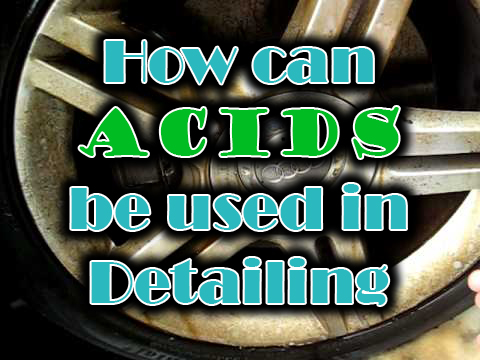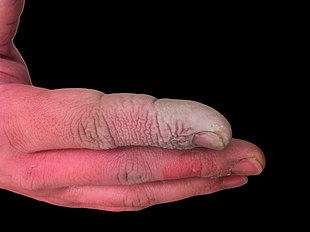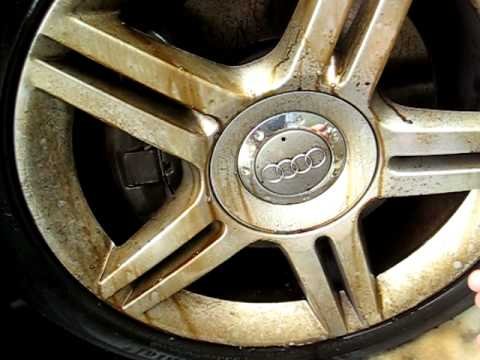UTAH’S DETALING SERVICE
FROM COUPES TO SEMI TRUCKS WE ARE FULLY EQUIPPED TO HANDLE BIG AND SMALL DETAILING JOBS FROM INTERIOR CLEANING TO FULL PAINT CORRECTION.
REQUEST APPOINTMENT
How Acids can be used in Detailing
Posted January 23, 2020 by Chris Blaisdell, Onsite Detail
In the auto detailing industry there are so many products and chemicals that it can truly get confusing. The research and development that has been put in has truly changed the way we can do our job and serve our customers. There are a large array of products that fulfill many different needs and are used for specific purposes. There are also many products that can be used as general cleaners and protectors. One product/chemical that can be quite controversial. This controversial chemical is acid.
In detailing there are many reasons not to use acids. There are many different chemicals with acidic bases that are used for a wide variety of purposes. For the purpose of this blog we are just going to talk about two that are straight acids. These are not to be used without proper PPE (personal protection equipment) and training and consideration for the environment.
HYDROFLUORIC ACID
This acid is EXTREMELY DANGEROUS. It is probably one of the, if not, the most dangerous acid ever created. When used correctly can produce amazing results and make a nightmare job less of a nightmare. However, if inhaled or spilled directly on your skin, it can cause serious health hazards – even death. Don’t take this stuff lightly. Be sure to wear protective eye wear and gloves and even a mask if you can. If you get any on your skin, stop what you are doing right away and wash the affected area thoroughly. 
Also, when rinsing from rims or wherever it is being used, be sure to rinse the area very well. It will start to weaken any protective coating if it is left on for longer than a few seconds. All you really want the acid to do is to penetrate and break down any built-up brake dust, road salt, dirt, oils, or any other contaminants that may have built up on the rim or tire. The acid works quickly when it comes to breaking those things down. This is why you don’t want to leave the acid on the surface for very long. You will want to do one area at a time. After spraying the acid on the area, you will only need to wait 20-30 seconds before spraying it off unless its drying then get it rinsed off faster. Even the experienced detailer SHOULD NOT be spraying more than one area at a time with hydrofluoric acid. If there are any weaknesses in the surface as far as any protective coating or any rusting the acid will find it. Acid does not care what material you are when it is applied. It will weaken anything that it touches especially if it is left on said material. Be sure to check what the dilution you should be before working with it. Ask manufacturers of the acid how it should be diluted and used. That’s why this acid is so dangerous and should be handled with extreme care. Although this acid may be the most effective and very widely used. It is not my first choice and not my go-to. At Onsite Detail we actually don’t use this type of acid.
HARD-WATER REMOVAL ACID (SULFURIC ACID)
When needing an acid, my go-to is actually a hard-water removal acid. This may be coming from a biased perspective because I’ve used hard water acid a lot more than any other kind of acid. It still needs to be handled with great care and you should use the same precautions when using it as you do with hydrofluoric acid. It does remove or break down more than just hard water. For most cases where acid would be used, this sulfuric acid can accomplish the same tasks as any other kind of acid without the intense bodily harm that can come with the hydrofluoric acid.
One of the things that I like best about the hard-water acid is that I like to use it when I’m doing a hard-water removal wash on the body of the vehicle. When using it on the body of the vehicle, this acid is not as dangerous or fast-acting as some other acids, it should still be held to one panel at a time when doing an acid wash on the paint. The acid will still break down and weaken anything that it touches and you will want to monitor that area you are working very closely. If you can tell that the clear coat is already weakened or peeling off, using acid may not be a good choice or put the acid on a rag and wipe around the weakened area may be effective. Pretty much the only reason that you would be doing an acid wash on a vehicle’s paint is because of hard water or a major decontamination.
It will not take away any scuffs or scratches. For that you will need to have paint correction done which is a much more extensive process than just an acid wash. Pre-spraying with water on the rim, paint or glass before applying the acid is strongly encouraged but optional if you know and understand what you are doing.
Acid on Wheels/Rims
Depending on what your rim is made of, it will be the deciding factor of what kind of acid you should use or if you should use any acid at all. Diluted acid DOES NOT affect if the acid will work or not. It does, however, affect how fast the acid will work when applied. The more the acid is diluted the slower the acid will take to break down the contaminants. This is why the rinsing step is important after using it. If any acid, even diluted, is left on the surface it is applied and not completely removed – it can still eat away at any material. It will take much more time with a very small amount of acid but you still want to make sure that the acid is completely removed. Don’t get shy with the pressure washer or sprayer. Spray a generous amount of water on the area to make sure that the acid is completely rinsed off and removed from the area. When dealing with acid, be sure to keep a close eye on the area you are working on.
Detailing chemicals all need to be handled with great care. It is smart, and truthfully necessary, to read the labels of any chemicals or acids before using, including dilution, protective wear, etc. Be smart and be careful.
Here at Onsite Detail we go through training and learn and practice safe use of detailing chemicals. As Certified Detailers we work hard to ensure you and your vehicle are taken care of properly and we get the best results we can on each detail service.
If you have a vehicle that needs some heavier decontamination, such as over spray removal, rust spot removal, oil or grease contamination removal, tree sap removal, hard water removal, or if your once shiny rims are now black and covered in brake dust feel free to reach out and schedule a detail with us. On the other hand if you have a nice vehicle and just want it maintained and protected please reach out and give us a call or text at (801) 412-9274. Let us know what we can do for you! Happy detailing and safe travels.
by Andy Stallings, CD, Operations Manager, Onsite Detail